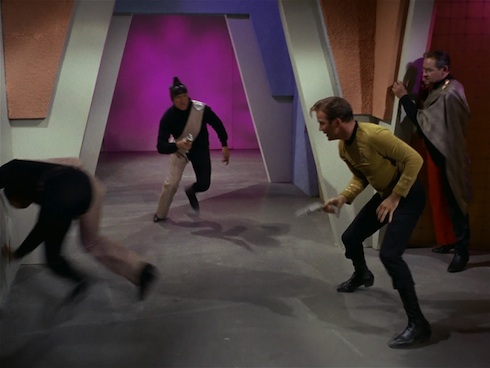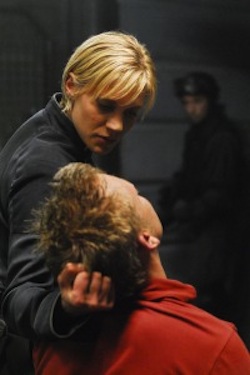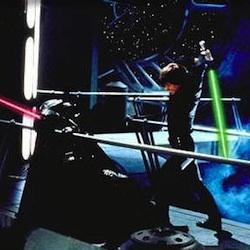Last month, I worried about the dominance of violent action-oriented SF films at the expense of thoughtful, non-violent ones. This kicked off a great conversation among many of our readers, with some of you pointing out brainy films I’d missed, while others arguing the merits of violence in science fiction. Recently, Emmet Asher-Perrin noticed the violent turn the Doctor has taken on Doctor Who. Violence does indeed have a place in science fiction; so much so, that I would argue that much of science fiction actually needs violence. And the reason is that in order to be effective fiction, science fiction has to comment on the real world.
In the film Adaptation, Charlie Kaufman (Nicholas Cage) attends a writing workshop where he pitches an idea for a movie in which “not much happens” and is more a reflection of “the real world.” The workshop leader, Robert McKee (Brian Cox) accosts him with a list of horrific and terrible things that happen every day in the “the real world” and proclaims that if Charlie can’t find those things in life to put into his fiction that he doesn’t know anything about life and that he will “bore his audience to tears.” Most everyone knows conflict is central to the art of storytelling, but where does violence fit into science fiction specifically?
Science fiction that takes place in the future often questions how humans will behave in an enlightened society. Star Trek generally asserts that humans have improved and are much nicer than they were in Earth’s past when WWIII and the Eugenics Wars were going on. Still, Captain Kirk is beating the crap out of people on an almost weekly basis and likes admitting how humans are basically barbaric and killers at the core. This question is depicted over and over again in the 60s show and summed up best in the episode “A Taste of Armageddon.” In this one, the Enterprise encounters two planets that fight their wars with computers, rather than actual weapons. Casualties are calculated, and victims are then assigned to incineration booths. The citizens of this planet claim they’ve taken away the “barbarism” of war by making it a clean part of their society.

Kirk is outraged and proceeds to start shooting up the whole planet up in an effort to prove why war is such a dangerous thing. At the end of the episode Kirk clearly outlines the reason why war is so terrible is because of how gruesome and violent it is. By having a sterile war, the people on these planets have forgotten why violence and killing are so bad in the first place.
Seen retroactively, this Trek episode serves not only as great social commentary about war, but also commentary about the portrayal of violence in fiction itself. If violence is indeed too clean and too perfect in fiction, we cease to become afraid of it, and tension doesn’t work. A lot of what is troublesome about violence in big-budget action films is just this, if fails to actually remind us of real violence, and thus simply exists within the context of a movie. But how can worlds of robots and ray guns legimately scare us and make commentary on actual violence?
In Alfred Bester’s short story “The Pi Man” the main character is depicted as a sort of agent of chaos who randomly must be both good and evil in order to maintain some kind of mathematic balance in the universe. Thus the character is saving people from doom one second, only to turn around in the next scene and murder someone senselessly. Because these actions are unpredictable, they are effective in terms of shock value. But then, when the reasons for the violence are weaved into a science fiction premise, the story is able to mediate on the subject of violence itself. Similarly, Harlan Ellison’s “I Have No Mouth and I Must Scream” gives us a sadistic computer, which is repeatedly killing off a group of humans only to revive them and kill them in new and horrific ways. Though, the purpose of the story isn’t played exclusively for horror, but rather to comment on how the people begin to treat each other in this dire situation. Under extreme circumstances, the realities of humanity are often revealed, and what’s a more extreme circumstance than a science fiction premise?
 In a recent interview on The New Yorker’s blog, author Mary Gaitskill commented on the way violence is incorporated into our lives and the creative process saying; “…most people sublimate the violence, are even able to use it in a creative way. There’s an interesting and very terrible line between that sublimation and more overt expression, a line that gets dramatically crossed in wartime situations…” The act of sublimation seems to be the key here. If science fiction, or any fiction, tackles violence it would seem the route would need would to be an acknowledgement without a celebration. This is not to say all forms of violence need to be social commentary. Thinking about Gaitskill’s quote about crossing the line in wartime brings to mind Battlestar Galactica. When the character of Starbuck shoots a Cylon spaceship out of the sky, we cheer. When she waterboards a Cylon prisoner, we cringe. In fact, the use of more realistic violence in Battlestar is part of what made the drama of that show so effective. Instead of having synthetic life forms be murderous robots that looked like toasters, the synthetic lifeforms were murderous robots that looked human and we called them toasters.
In a recent interview on The New Yorker’s blog, author Mary Gaitskill commented on the way violence is incorporated into our lives and the creative process saying; “…most people sublimate the violence, are even able to use it in a creative way. There’s an interesting and very terrible line between that sublimation and more overt expression, a line that gets dramatically crossed in wartime situations…” The act of sublimation seems to be the key here. If science fiction, or any fiction, tackles violence it would seem the route would need would to be an acknowledgement without a celebration. This is not to say all forms of violence need to be social commentary. Thinking about Gaitskill’s quote about crossing the line in wartime brings to mind Battlestar Galactica. When the character of Starbuck shoots a Cylon spaceship out of the sky, we cheer. When she waterboards a Cylon prisoner, we cringe. In fact, the use of more realistic violence in Battlestar is part of what made the drama of that show so effective. Instead of having synthetic life forms be murderous robots that looked like toasters, the synthetic lifeforms were murderous robots that looked human and we called them toasters.
 Cartoon violence or “comic-book” violence is often attributed to science fiction because it is the genre of the imagination. But when one thinks about stories like “I Have No Mouth and I Must Scream” imaginative forms of violence don’t necessarily mean unrealistic depictions of the human condition. Battlestar Galactica was smart to use real bullets and real guns to make the stakes of the violence seem bigger. But, one could argue, that thematically, Luke Skywalker tossing aside his lightsaber (the most ridiculous tool of violence ever) is just as effective in terms of sublimation of violence. If what’s at stake is Luke murdering his own father because of some sort of bizarre power bloodlust, then it doesn’t matter if he’s going to do it with a lightsaber or an icepick. Luke is actually doing in this scene a sort of version of what Kirk says in “A Taste of Armageddon”, he’s saying that he won’t kill today.
Cartoon violence or “comic-book” violence is often attributed to science fiction because it is the genre of the imagination. But when one thinks about stories like “I Have No Mouth and I Must Scream” imaginative forms of violence don’t necessarily mean unrealistic depictions of the human condition. Battlestar Galactica was smart to use real bullets and real guns to make the stakes of the violence seem bigger. But, one could argue, that thematically, Luke Skywalker tossing aside his lightsaber (the most ridiculous tool of violence ever) is just as effective in terms of sublimation of violence. If what’s at stake is Luke murdering his own father because of some sort of bizarre power bloodlust, then it doesn’t matter if he’s going to do it with a lightsaber or an icepick. Luke is actually doing in this scene a sort of version of what Kirk says in “A Taste of Armageddon”, he’s saying that he won’t kill today.
Conversely, when the 10th Doctor picks UP a gun in “The End of Time” the statement that an emphatically peaceful person would reverse their pacifism for one reason, sublimates violence in the opposite direction by calling into question its possible utility to end other violence.
But in order to get Luke, Kirk, or the Doctor to that point of sublimation, we had to believe the violence was real. Because without acknowledging that, none of these works of science fiction would seem real. And the best science fiction is always real.
Ryan Britt is a staff writer for Tor.com. His commentary on science fiction has also been featured with Clarkesworld Magazine. His other writing has appeared with Nerve.com, Opium Magazine and elsewhere.









